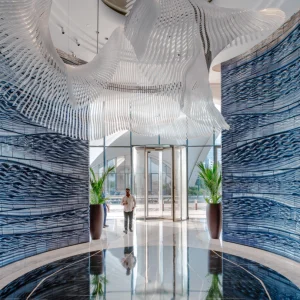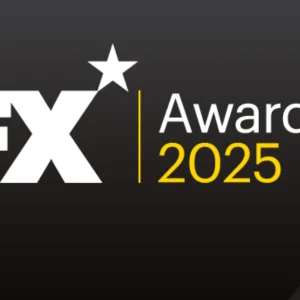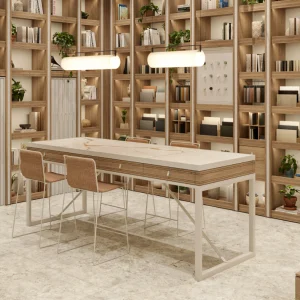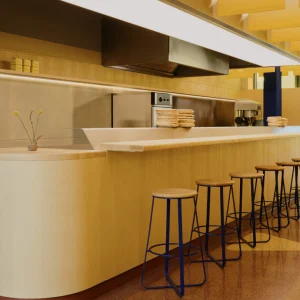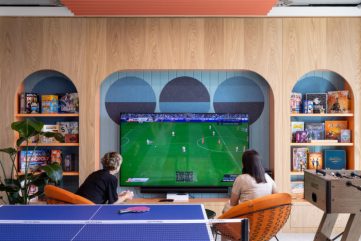
AS BW: WORKPLACE EXPERTS celebrates its 25th year in 2025, looking back, there have been numerous changes to the office. At the turn of the millennium, uniform office layouts that prioritised function over comfort were standard, dominated by open-plan design into 2005 and beyond. Breakout areas were introduced to promote that social factor and, with growing outsourcing and global workforce management, hot-desking became more common.
The rise of tech giants like Facebook and Google heralded a new vision, with campusstyle workplaces featuring game rooms, gyms, bean bags and bars. One-size-fit offices of the past were replaced by creative environments with more shared spaces to foster connection and innovation. However, the burst of the dot-com bubble tightened fitout budgets, and the global financial crisis that followed in 2007-2008 further squeezed spending, leading to smaller revamps rather than major overhauls.
 Skyscanner’s offices in Soho incorporates social spaces
Skyscanner’s offices in Soho incorporates social spaces
Reflecting on the changes during this time, John Wozniak, sustainability manager at BW: Workplace Experts, said: ‘In 2007, it became illegal to smoke in enclosed public places including workplaces in England, which helped to kickstart the beginning of the well-being movement in offices. Since then, well-being and sustainability has continued to gain momentum, with things like better air quality and lighting prioritised in offices, although this was only the beginning and in the 2010s and beyond, businesses are much more focused on offices that are more inclusive and adaptable with an emphasis on reducing carbon.’
Entering the 2010s, sustainability was firmly on the agenda nationally and globally. This impacted the office market, with green building certifications and energy-efficient systems playing a bigger part in projects.
The millennial workforce influenced office culture, and the popularity of agile and activity-based working – where employees choose spaces that best match their tasks – led to more adaptable layouts with modular furniture and flexible partitioning. Offices were designed and thoughtfully arranged to offer a mix of spaces, with an emphasis on flexibility and collaboration that also led to co-working gaining traction.
Peter Nagle, joint managing director at BW: Workplace Experts, said: ‘In the 2010s era, we completed one of my favourite office projects for Estée Lauder, close to London’s Oxford Street, which encapsulated how the office was starting to cater to not only offer a workspace, but an experience for employees. The dramatics of this office and hotel-style luxury was an example of how offices weren’t purely a functional endeavour, and although this was for a luxury brand, it was a trend we started to see more for the offices of smaller brands too.’
Over the following five years, digital transformation reached new heights, with rapid adoption of online collaboration tools. The Internet of Things and AI came into public consciousness, and designs increasingly incorporated smart lighting, audio-visual systems, and high-speed internet infrastructure.
Sustainability grew in urgency as awareness around the climate crisis intensified, and the UK set its ambitious 2050 net-zero target. Environmental responsibility became a differentiator for people when considering potential workplaces, and ESG criteria informed commercial property design.
Brexit further spurred the globalisation of the workforce, as did the rise of the gig economy and freelancing. Consequently, more companies opted for multi-functional spaces that could serve different purposes throughout the day.
As employers sought to attract and retain top talent, interior fit-outs were more tailored to users, with a shift towards human-centric design and employee well-being. Biophilic design, natural light and air quality became key considerations for health and stress reduction, and offices offered more outdoor spaces, gyms and meditation rooms.
Daniel Callegari, head of design – design and build division at BW: Workplace Experts, said: ‘The seamless operation and integration of technology and lighting in offices has evolved over time to help adapt how we view space and interact with it. The office is a much more humanised environment now, and we are seeing design that more than ever helps people to engage with the building – whether that’s through wayfinding, lighting control to drive traffic through a space, or even changing the colour of lighting in office pods and rooms, which taps into colour psychology and enhancing mood.’
The pandemic hitting in 2020 fundamentally disrupted the concept of the traditional ‘workplace’, necessitating a shift to remote and hybrid work. Health and safety protocols became central design elements, with touchless technologies for lifts, doors and faucets, and improved air filtration and space utilisation.
Organisations re-evaluated their physical office requirements in the post-pandemic economic slowdown. Cautious about planning for large capital investments but wanting to adapt to new working patterns, projects focused on creating smaller, high-quality, digitally enabled and easily reconfigurable spaces that maximise collaboration and interaction, with fewer fixed desks and more moveable parts. Energy-efficient buildings became the standard, and fit-out projects prioritised lowcarbon materials and renewable energy to lower environmental impact.
In our survey of 2,000 UK office workers, ‘Workplace Environments in a Hybrid World’, we found that four walls and a desk will not meet the needs of today’s workforce. In fact, the most valuable spaces according to 34% are available meeting rooms, adequate amounts of breakout spaces and social spaces. Adding to this, 27% said that they also value wellness spaces (e.g. exercise or meditation rooms), 10% also said that access to the outdoors would encourage them to spend time at the office if they are a hybrid worker.
Together with natural light, fresh air, comfortable furniture, and space for relaxation, these trends tie in with wider employment rights reform, among them the government’s recent pledge to give people the ‘right to switch off’ outside working hours to address burnout. Supporting inclusivity and accessibility will also be crucial, and genderneutral bathrooms, nursing rooms, and prayer spaces may become common features to better reflect a diverse workforce.
More than ever, all design decisions will be based on decarbonisation and increasingly stringent sustainability standards from the earliest stages. This will encompass circular economy principles, reusing and recycling where possible to reduce waste and emissions. Accreditations including BREEAM, LEED and WELL will be minimum requirements, and offices will be designed with climate resilience in mind to counteract rising temperatures and extreme weather.
 Anthony Brown, CMO at BW: Workplace Experts
Anthony Brown, CMO at BW: Workplace Experts
Technology, too, will be ever more integral, with virtual and augmented reality, AI-powered systems, automation and data analytics, enriching communication and unearthing insights to continually optimise workspaces.
Looking ahead, carefully crafted workplace design that responds to the evolution of how we live and work is the way to create spaces that are fit for purpose in a new era – supporting motivation, productivity and positive experiences in environments where people and businesses can truly thrive.
PREDICTING THE FUTURE of the workplace often raises more questions than answers. The way people use workspaces has undergone a seismic shift – from how frequently they are used to the very willingness to use them. As workplace strategists, our role is to understand these evolving needs, stay ahead of changes, and lay the groundwork to support today’s workforce while future-proofing the workplaces of tomorrow.
While every organisation has unique operational and functional requirements, one constant remains: the end users – the workers who interact and collaborate in these spaces. A human-centric approach ensures that people are at the heart of the design process. Purposeful workplace design not only meets immediate functionality but also aligns with the core needs of employees and the mission of the organisation. This transforms the workplace into an extension of company values and a driver of employee satisfaction and productivity. Understanding the people and the organisation’s purpose makes answering the bigger strategic questions easier.
 Clare Danahay, director of workplace at WILL+Partners
Clare Danahay, director of workplace at WILL+Partners
A holistic approach is essential in workplace strategy. This involves gathering quantitative data, like satisfaction surveys and utilisation studies, alongside qualitative insights from focus groups and workshops. Our aim is to develop a comprehensive understanding of both the hard facts and the nuanced experiences of employees. By bridging data with a human-centric design approach, we incorporate critical information to craft functional, enjoyable workspaces that serve people well for years to come.
Designing with purpose ensures that the workplace transcends its role as just a space for work; it becomes a tool for cultivating employee engagement and well-being. Every design choice – from collaborative zones to quiet areas – reflects the company’s mission and supports diverse work styles, enhancing the user experience and creating a purposeful, productive environment.
We are witnessing a cultural transition from prioritising productivity alone to focusing on the overall employee experience. Office spaces, once inflexible and outdated, are now being reimagined to meet the needs and preferences of today’s workforce. This new approach prioritises flexibility and autonomy, empowering employees to choose how and where they work. It fosters collaboration, community, and a sense of ownership, accommodating various work styles and personal preferences. Spaces that cater to purpose-driven work – where employees feel their role contributes to a larger mission – unlock the full potential of the workforce.
Workplace strategy is an ongoing, evolving process that adapts to the changing needs of organisations and employees. By actively listening to workers and regularly reviewing data-driven insights, we ensure continuous improvement and prevent complacency. This commitment to engagement throughout the workplace’s lifecycle sustains a vibrant, adaptable work environment that supports both business goals and individual well-being.

